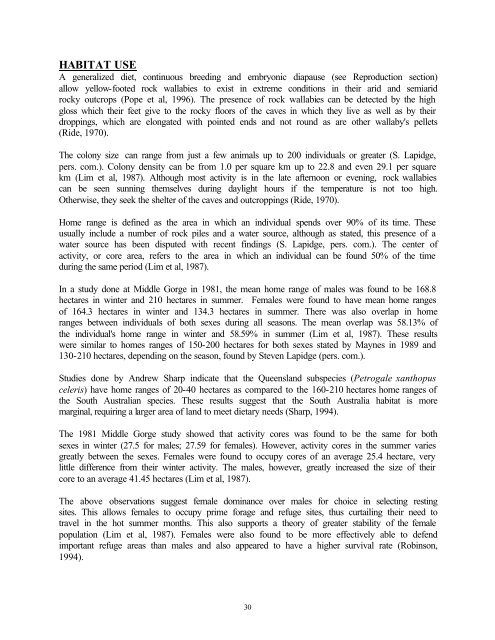Yellow-footed Rock Wallaby Husbandry Manual - Marsupial and ...
Yellow-footed Rock Wallaby Husbandry Manual - Marsupial and ...
Yellow-footed Rock Wallaby Husbandry Manual - Marsupial and ...
Create successful ePaper yourself
Turn your PDF publications into a flip-book with our unique Google optimized e-Paper software.
HABITAT USE<br />
A generalized diet, continuous breeding <strong>and</strong> embryonic diapause (see Reproduction section)<br />
allow yellow-<strong>footed</strong> rock wallabies to exist in extreme conditions in their arid <strong>and</strong> semiarid<br />
rocky outcrops (Pope et al, 1996). The presence of rock wallabies can be detected by the high<br />
gloss which their feet give to the rocky floors of the caves in which they live as well as by their<br />
droppings, which are elongated with pointed ends <strong>and</strong> not round as are other wallaby's pellets<br />
(Ride, 1970).<br />
The colony size can range from just a few animals up to 200 individuals or greater (S. Lapidge,<br />
pers. com.). Colony density can be from 1.0 per square km up to 22.8 <strong>and</strong> even 29.1 per square<br />
km (Lim et al, 1987). Although most activity is in the late afternoon or evening, rock wallabies<br />
can be seen sunning themselves during daylight hours if the temperature is not too high.<br />
Otherwise, they seek the shelter of the caves <strong>and</strong> outcroppings (Ride, 1970).<br />
Home range is defined as the area in which an individual spends over 90% of its time. These<br />
usually include a number of rock piles <strong>and</strong> a water source, although as stated, this presence of a<br />
water source has been disputed with recent findings (S. Lapidge, pers. com.). The center of<br />
activity, or core area, refers to the area in which an individual can be found 50% of the time<br />
during the same period (Lim et al, 1987).<br />
In a study done at Middle Gorge in 1981, the mean home range of males was found to be 168.8<br />
hectares in winter <strong>and</strong> 210 hectares in summer. Females were found to have mean home ranges<br />
of 164.3 hectares in winter <strong>and</strong> 134.3 hectares in summer. There was also overlap in home<br />
ranges between individuals of both sexes during all seasons. The mean overlap was 58.13% of<br />
the individual's home range in winter <strong>and</strong> 58.59% in summer (Lim et al, 1987). These results<br />
were similar to homes ranges of 150-200 hectares for both sexes stated by Maynes in 1989 <strong>and</strong><br />
130-210 hectares, depending on the season, found by Steven Lapidge (pers. com.).<br />
Studies done by Andrew Sharp indicate that the Queensl<strong>and</strong> subspecies (Petrogale xanthopus<br />
celeris) have home ranges of 20-40 hectares as compared to the 160-210 hectares home ranges of<br />
the South Australian species. These results suggest that the South Australia habitat is more<br />
marginal, requiring a larger area of l<strong>and</strong> to meet dietary needs (Sharp, 1994).<br />
The 1981 Middle Gorge study showed that activity cores was found to be the same for both<br />
sexes in winter (27.5 for males; 27.59 for females). However, activity cores in the summer varies<br />
greatly between the sexes. Females were found to occupy cores of an average 25.4 hectare, very<br />
little difference from their winter activity. The males, however, greatly increased the size of their<br />
core to an average 41.45 hectares (Lim et al, 1987).<br />
The above observations suggest female dominance over males for choice in selecting resting<br />
sites. This allows females to occupy prime forage <strong>and</strong> refuge sites, thus curtailing their need to<br />
travel in the hot summer months. This also supports a theory of greater stability of the female<br />
population (Lim et al, 1987). Females were also found to be more effectively able to defend<br />
important refuge areas than males <strong>and</strong> also appeared to have a higher survival rate (Robinson,<br />
1994).<br />
30




